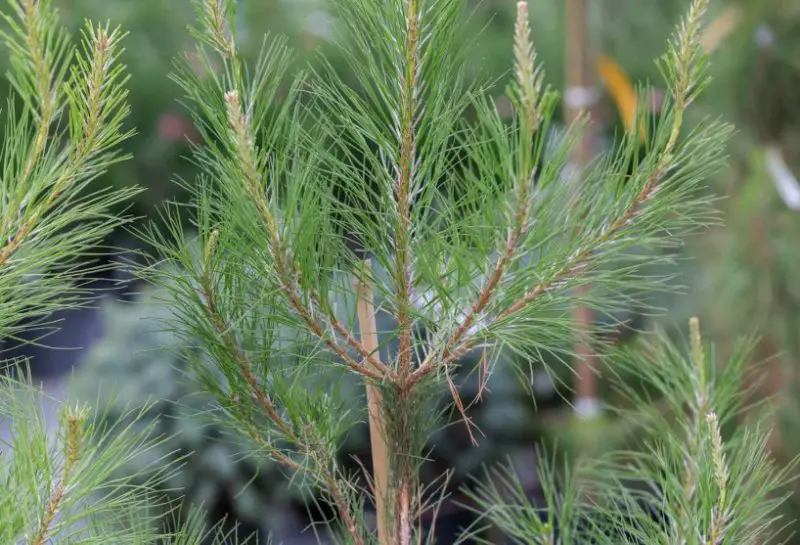Loblolly Pine (Pinus taeda) is one of the most common pine species in the southeastern United States. Its rapid growth, adaptability, and economic value make it a popular choice for both commercial forestry and residential landscaping.
This comprehensive guide will provide detailed insights into the care and growing requirements of Loblolly Pine to ensure healthy and vigorous growth.
Overview of Loblolly Pine (Pinus taeda)

Loblolly Pine is a fast-growing evergreen tree that thrives in warm, humid climates. It is commonly found in lowland areas, hence the name “loblolly,” which refers to a type of wetland. Here are some key characteristics of this tree:
- Scientific Name: Pinus taeda
- Common Names: Loblolly Pine, Southern Yellow Pine
- Family: Pinaceae
- Native Range: Southeastern United States
- Growth Rate: Fast (2-3 feet per year)
- Mature Height: 60-100 feet
- Lifespan: 100-300 years
- USDA Hardiness Zones: 6-9
Benefits of Growing Loblolly Pine
Rapid Growth and High Yield
Loblolly Pine (Pinus taeda) is widely recognized for its exceptionally fast growth rate, making it a preferred choice for commercial timber production and land restoration projects. Under optimal conditions, it can grow more than two feet per year, allowing for quicker harvest cycles compared to other pine species. This rapid development makes it an economically viable option for landowners seeking a profitable forestry investment. Additionally, its ability to reach maturity in as little as 25 to 30 years contributes to the consistent supply of high-quality wood for various industries.
Soil Stabilization and Erosion Control
One of the significant environmental benefits of Loblolly Pine is its ability to stabilize soil and prevent erosion. Its deep and extensive root system firmly anchors the soil, reducing the risk of landslides and degradation in areas prone to heavy rainfall or deforestation. This characteristic makes it especially valuable in reforestation and land rehabilitation efforts, where restoring soil health is a priority. Moreover, the thick layer of fallen pine needles creates a natural mulch, further enhancing soil moisture retention and reducing surface runoff.
Essential Habitat for Wildlife
Loblolly Pine plays a crucial role in maintaining biodiversity by providing shelter and sustenance to a variety of wildlife species. The dense canopy offers nesting sites and protection for birds such as woodpeckers, owls, and warblers. Its seeds serve as a vital food source for small mammals, including squirrels and chipmunks, while larger animals like deer often seek refuge within its forests. Additionally, the presence of these trees fosters the growth of understory vegetation, creating a rich and diverse ecosystem that supports multiple species throughout the year.
Valuable Resource for Timber and Pulpwood
As one of the most important commercial tree species in the southeastern United States, Loblolly Pine is a primary source of softwood lumber and paper products. Its straight, tall trunks yield high-quality timber used in construction, furniture-making, and plywood production. The wood’s strength, workability, and resistance to warping make it ideal for a range of structural applications. Beyond solid wood products, the tree is a significant contributor to the pulp and paper industry, with its fibers being processed into paper, cardboard, and other cellulose-based materials. The versatility and economic value of Loblolly Pine make it a cornerstone of the forestry sector.
Climate Adaptability and Sustainability
Another advantage of growing Loblolly Pine is its ability to thrive in diverse climatic conditions. It is well-suited to a variety of soil types, including sandy and clay-heavy soils, allowing it to grow in regions where other species might struggle. Additionally, its tolerance to high temperatures and moderate drought conditions makes it a resilient choice in the face of climate change. With responsible forest management, Loblolly Pine can be grown and harvested sustainably, ensuring a continuous supply of timber while maintaining ecological balance.
Ideal Growing Conditions
Climate Requirements
Loblolly Pine thrives in warm, humid climates, making it particularly well-suited for the southeastern United States. It flourishes in regions with long, hot summers and mild winters, allowing for continuous growth throughout much of the year. While it is primarily adapted to USDA hardiness zones 6 through 9, it can withstand occasional cold snaps without significant damage. However, prolonged exposure to harsh winter conditions may slow its growth and affect its overall health. The tree also demonstrates resilience in the face of seasonal droughts, although consistent moisture levels promote the best growth results.
Soil Preferences
The adaptability of Loblolly Pine to a variety of soil types is one of its key advantages, making it a versatile species for reforestation and commercial forestry. It grows best in well-draining soils, with a preference for sandy, loamy, or clay-based substrates. The ideal pH range for optimal development falls between 4.5 and 7.5, allowing it to thrive in both slightly acidic and neutral soils. While it has a strong tolerance for occasional dry periods, Loblolly Pine performs best in moderately moist conditions where water availability is sufficient but not excessive. Poorly drained soils or areas prone to waterlogging can hinder root development and increase the risk of disease.
Sunlight Requirements
As a sun-loving species, Loblolly Pine requires abundant direct sunlight to reach its full growth potential. It should receive at least six to eight hours of unfiltered sunlight each day to maintain healthy development. Limited sun exposure can result in stunted growth, reduced foliage density, and weaker overall structure. Open landscapes, clearings, and areas with minimal competition from taller trees provide the best conditions for maximizing its growth rate and overall vitality.
Planting Loblolly Pine
Selecting the Right Location
Choosing an appropriate site is crucial for the healthy growth of a Loblolly Pine. This species thrives in areas that receive full sunlight for at least six to eight hours a day. Since Loblolly Pines can grow up to 100 feet tall and spread up to 30 feet wide, they require ample space to develop without interference from buildings, power lines, or other large trees. Well-drained soil is essential to prevent root rot and promote strong, deep root development. While Loblolly Pines are adaptable to various soil types, they grow best in sandy, loamy, or clay-based soils with good drainage. Avoid planting in areas prone to waterlogging or excessive shade, as these conditions can hinder growth and make the tree more susceptible to disease.
Best Time to Plant
The optimal time to plant Loblolly Pine is from late fall to early spring. During this period, cooler temperatures reduce transplant stress and allow the roots to establish before the intense heat of summer arrives. Fall planting is particularly beneficial in regions with mild winters, as it gives the tree a longer window to acclimate before the growing season begins. If planting in early spring, it is best to do so before new growth emerges to minimize disruption. Avoid planting during the peak of summer, as high temperatures and dry conditions can put excessive stress on young trees and reduce their chances of survival.
Steps for Planting
- Dig a Hole
Start by digging a hole that is approximately twice as wide and as deep as the root ball of the young Loblolly Pine. A wider hole allows the roots to spread more easily, promoting faster establishment and reducing transplant shock. - Prepare the Soil
If the native soil is poor or heavily compacted, consider mixing it with organic matter such as compost or well-rotted manure. This can enhance soil structure, improve drainage, and provide essential nutrients for early growth. However, avoid adding too much fertilizer at this stage, as excessive nutrients can overwhelm young roots. - Place the Tree
Carefully position the tree in the hole, ensuring that the root flare (where the roots begin to spread from the trunk) is level with or slightly above the ground surface. Planting too deep can suffocate the roots, while planting too shallow may leave them exposed and vulnerable to drying out. If the tree is container-grown, gently loosen the roots to encourage outward growth. - Backfill the Hole
Refill the hole with the excavated soil, pressing it down gently to eliminate air pockets. Avoid compacting the soil too firmly, as this can restrict root expansion. Watering intermittently while backfilling can help the soil settle naturally. - Water Thoroughly
After planting, provide a deep, slow watering to help the roots establish contact with the soil. Ensure the soil remains consistently moist but not soggy during the first few weeks after planting. Regular watering is essential, especially in dry conditions, to support initial root development. - Apply Mulch
Spread a 2- to 3-inch layer of mulch around the base of the tree, leaving a small gap around the trunk to prevent rot and pest issues. Mulch helps retain moisture, regulate soil temperature, and suppress weed growth. Organic mulch such as pine needles, wood chips, or shredded bark is ideal for promoting long-term soil health.
Care and Maintenance
Watering Requirements
Proper watering is essential for the successful establishment and long-term health of Loblolly Pine trees. Young trees require consistent moisture to develop a strong root system. During the first year after planting, they should receive a deep watering at least once a week, ensuring that the soil remains moist but not waterlogged. Deep watering encourages the roots to grow downward in search of moisture, which enhances drought resistance as the tree matures.
As Loblolly Pines grow, their water needs decrease significantly. Mature trees are highly drought-tolerant and can withstand dry spells without major issues. However, during prolonged periods of drought, occasional deep watering can help maintain vigor and reduce stress. Providing water once every few weeks in extremely dry conditions can prevent premature needle drop and promote overall health. It is best to water deeply and infrequently rather than shallowly and frequently, as this ensures moisture reaches the deeper roots.
Fertilization
Applying fertilizer can enhance the growth of Loblolly Pine, especially in nutrient-poor soils. A balanced, slow-release fertilizer with an equal ratio of nitrogen, phosphorus, and potassium (such as 10-10-10) should be applied in early spring, just before the tree enters its active growing season. This provides essential nutrients that support strong trunk development, dense foliage, and overall resilience.
It is important to avoid over-fertilization, as excessive nitrogen can lead to rapid but weak growth, making the tree more susceptible to breakage in storms. In natural forested areas, Loblolly Pines often thrive without additional fertilization, as decomposing organic matter provides sufficient nutrients. For trees in landscaped settings or poor soils, fertilization once or twice a year can be beneficial, but it should always be done in moderation.
Pruning and Maintenance
Regular pruning helps maintain the health, structure, and appearance of Loblolly Pine trees. Removing dead, damaged, or diseased branches is essential to prevent infections and fungal growth. It is best to inspect the tree annually and remove any weak or broken limbs to reduce the risk of disease spreading to healthy parts of the tree.
Pruning lower branches can improve airflow around the trunk and enhance the tree’s overall aesthetics. However, care should be taken not to remove too many lower limbs at once, as this can expose the trunk to excessive sun and weaken the tree’s structure.
Structural pruning is best performed in early spring before the growing season begins. This involves selectively trimming branches to encourage a strong central leader and a well-balanced canopy. Young trees may require more frequent shaping, while mature trees typically need minimal pruning unless branches pose a safety hazard.
Pest and Disease Management
Loblolly Pine is a hardy species, but it is susceptible to several pests and diseases that can weaken or even kill the tree if left unmanaged. Proper tree care, including spacing, watering, and pruning, is essential in preventing infestations and infections.
Common Pests
- Southern Pine Beetle (Dendroctonus frontalis)
The Southern Pine Beetle is one of the most destructive pests affecting Loblolly Pines. These beetles bore into the bark, cutting off the tree’s ability to transport nutrients and water, often leading to death. Infestations are more likely when trees are stressed due to drought, overcrowding, or damage. To prevent outbreaks, maintain proper tree spacing to improve airflow and reduce competition for resources. Regular deep watering during dry periods can also help keep trees vigorous and less susceptible to beetle attacks. In cases of severe infestation, removing and destroying affected trees may be necessary to prevent the spread. - Aphids (Pine Bark Aphid and Pine Needle Aphid)
Aphids are small sap-sucking insects that cluster on branches and needles, causing yellowing and premature needle drop. While mild infestations are usually not a major threat, large populations can weaken trees and produce a sticky substance called honeydew, which encourages sooty mold growth. Natural predators such as ladybugs help keep aphid populations in check. For severe infestations, applying insecticidal soap or horticultural oils can help eliminate these pests without harming beneficial insects. - Pine Tip Moth (Rhyacionia spp.)
Pine Tip Moths primarily target young Loblolly Pines, tunneling into the shoots and causing stunted growth and deformed branches. Infestations are most common in newly planted trees and can significantly hinder their development. To manage Pine Tip Moths, prune and destroy affected shoot tips before larvae mature into adults. In high-risk areas, applying an appropriate insecticide during early spring, when eggs hatch, can help prevent damage. Maintaining tree vigor through proper watering and fertilization also reduces susceptibility.
Common Diseases
- Fusiform Rust (Cronartium quercuum f. sp. fusiforme)
Fusiform Rust is a fungal disease that creates elongated, swollen galls on stems and branches, which can weaken or kill the tree. This disease requires both pine trees and oak trees to complete its life cycle, making mixed forests more susceptible. The best preventive measure is planting disease-resistant Loblolly Pine varieties. If infections occur, pruning and removing affected branches can help slow disease progression. Severely infected trees that pose structural risks may need to be removed. - Needle Blight (Lecanosticta acicola and Dothistroma spp.)
Needle Blight is a fungal disease that causes browning, premature needle drop, and reduced photosynthesis, weakening the tree over time. The risk of infection increases in humid conditions, especially when trees are densely planted. To prevent Needle Blight, ensure good air circulation by maintaining proper spacing between trees and pruning overcrowded branches. Avoid overhead watering, as excess moisture on foliage encourages fungal growth. If infection occurs, applying fungicides in early spring can help manage the disease. - Root Rot (Phytophthora and Heterobasidion annosum)
Root Rot is caused by soilborne fungi that attack the roots, leading to wilting, yellowing, and eventual tree decline. Poorly drained soils and overwatering create ideal conditions for fungal growth. Preventing this disease starts with selecting a well-drained planting site and avoiding excessive soil moisture. Infected trees often show signs of decay at the base and may need to be removed to prevent further spread. Fungicidal treatments are generally ineffective once Root Rot is established, making prevention the best approach.
Propagation Methods
Loblolly Pine can be propagated through both seeds and cuttings, though seed propagation is the most common and effective method. Each approach has its advantages, depending on the grower’s goals.
Propagating from Seeds
Growing Loblolly Pine from seeds is the most reliable and widely used method, particularly in large-scale forestry and reforestation projects. This method ensures genetic diversity and produces strong, adaptable trees.
- Collecting Seeds
Seed collection begins in the fall when mature cones turn brown and begin to open. Cones should be harvested directly from trees rather than collecting fallen ones, as seeds from fresh cones have a higher viability rate. Once collected, place the cones in a warm, dry location to allow them to fully open and release the seeds. Shaking or lightly tapping the cones can help extract the seeds more efficiently. - Stratification Process
To improve germination rates, Loblolly Pine seeds require stratification, a process that simulates winter conditions to break dormancy. Place the seeds in a plastic bag filled with slightly moist sand or peat moss, then store them in a refrigerator at 34-40°F (1-4°C) for 30 to 60 days. This cold treatment enhances the likelihood of successful sprouting when planted. - Planting and Germination
After stratification, plant the seeds in a well-draining soil mixture, such as a blend of sandy loam and organic matter. Sow the seeds at a depth of approximately ¼ to ½ inch and space them apart to allow room for growth. Keep the soil consistently moist but not waterlogged. Germination typically occurs within 10 to 20 days in warm temperatures. Seedlings should be kept in a bright location with indirect sunlight until they develop strong roots and can be transplanted outdoors.
Propagating from Cuttings
Propagation through cuttings is less common but can be useful for cloning specific trees with desirable traits such as superior growth rate or disease resistance. However, this method requires more careful management and has a lower success rate than seed propagation.
- Selecting and Preparing Cuttings
Cuttings should be taken from healthy, vigorous trees, preferably young specimens, as they have better rooting potential. Choose 6- to 8-inch-long cuttings from the current season’s growth, ensuring they have at least three to four sets of needles. Using sharp, sterilized pruning shears, make a clean cut at a 45-degree angle to maximize the surface area for rooting. - Applying Rooting Hormone
To improve the chances of successful root development, dip the cut end of each cutting into a rooting hormone powder or gel containing indole-3-butyric acid (IBA). This hormone stimulates root growth and increases the likelihood of establishment. - Planting the Cuttings
Prepare a growing medium that is well-draining yet retains moisture, such as a mixture of peat moss, sand, and perlite. Insert each cutting about 2 inches deep into the soil, spacing them to allow airflow and prevent fungal issues. Water the medium lightly to keep it moist but not soggy. - Creating a Humid Environment
Since cuttings lack an established root system, they require high humidity to prevent dehydration. Covering the planting tray or container with a clear plastic dome or placing it in a greenhouse helps maintain humidity levels. Mist the cuttings regularly to keep the foliage hydrated. Root development typically takes several weeks to a few months. Once roots are well-formed, the cuttings can be gradually acclimated to outdoor conditions before being transplanted.
Both propagation methods have their benefits: seeds offer genetic variation and adaptability, while cuttings allow for the cloning of superior trees. Choosing the right method depends on the specific goals of the grower, whether for large-scale planting, selective breeding, or landscape use.
Common Uses of Loblolly Pine
Loblolly Pine is one of the most economically and ecologically valuable tree species in the southeastern United States. Its rapid growth, adaptability, and high wood yield make it a preferred choice for various industries and environmental purposes.
Timber and Construction
Loblolly Pine is a key resource in the timber and construction industry due to its strong, straight-grained wood. It is widely used to produce dimensional lumber, which is essential for framing houses, building decks, and constructing fences. The wood’s durability and workability also make it a common choice for plywood, paneling, and engineered wood products. Additionally, it is used in the production of furniture, cabinetry, and interior trim. The combination of strength and lightweight properties makes Loblolly Pine an excellent option for large-scale construction projects.
Paper and Pulp Industry
The fast growth and high wood fiber yield of Loblolly Pine make it a crucial raw material for the paper and pulp industry. The tree’s wood fibers are ideal for producing a variety of paper products, including newspapers, packaging materials, and office paper. Additionally, it is used in the manufacturing of cardboard, tissue products, and specialty papers. Due to its efficiency in fiber production, many paper mills rely on sustainable Loblolly Pine plantations to meet industry demands while minimizing deforestation in natural forests.
Landscaping and Reforestation
Beyond industrial use, Loblolly Pine plays a significant role in landscaping, afforestation, and conservation efforts. It is often planted as a windbreak to protect agricultural fields from strong winds and soil erosion. Its deep root system helps stabilize soil, making it valuable for erosion control projects in degraded or flood-prone areas. Loblolly Pine is also widely used in large-scale reforestation efforts, particularly in regions where forests have been cleared due to logging or land development. Its ability to grow quickly and adapt to different soil conditions makes it an excellent choice for restoring forested landscapes.
Wildlife Conservation
Loblolly Pine forests provide essential habitat and food sources for various wildlife species. The tree’s seeds are an important food source for birds such as finches, woodpeckers, and wild turkeys. Deer and small mammals also benefit from the shelter and browse provided by young pine trees. In addition to serving as a food source, Loblolly Pine stands create nesting sites and protective cover for many forest-dwelling animals. Managing Loblolly Pine forests sustainably ensures a balanced ecosystem where both commercial and wildlife needs are met.
Conclusion
Loblolly Pine (Pinus taeda) is an excellent choice for those looking for a fast-growing, hardy tree that provides numerous benefits. By following the proper planting and care guidelines, you can ensure that your Loblolly Pine thrives for many years. Whether for timber, landscaping, or environmental benefits, this resilient tree is a valuable addition to any landscape.






